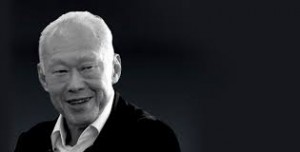Singapore, an island with no natural resources, migrated citizens was transformed from a tiny struggling island into one of the world’s richest economy. In 1950’s Singapore talked of constitutional reforms and freedom (from Malaysia) and Mr. Lee Kuan Yew challenged and changed the governing structure of the country. Today Singapore’s admirers look to Singapore as an ideal model and Mr Lee as a sage. Mr.Lee got many things right , especially in his choice of economic managers. He tried to keep government small, the economy open and simple regulations, transparent and effective. Mr Lee deftly exploited the advantage of the location along the Malacca Strait which still remains in the top 3 ports of the world. This port estimated 40% of the world’s maritime trade which has poured Foreign investment in Singapore.
He served as the Prime Minister of Singapore for 31 years and his strategies to make Singapore world’s greatest economy was successful. Singapore faced a race riots in1960’s . To preserve the ethnic harmony quotas in public housing that enforce integration was given.
He was incorruptible, he kept government unusually clean, he paid its ministers and civil servants a very high salaries. They were the world’s best paid , to attract talent from private sectors and curb competition. The sense of external weakness and internal fragility became a major concern to Mr Lee. He made national defence his high priority, Singaporean men still perform two years of national service in the armed force.
He designed a system for clean and clear elections, but it has always been inconceivable for the PAP (People’s Action Party) to lose power. The only reason was Mr Lee and his good governance. Mr Lee maintained an economic growth of nearly 7% a year for four decades, he made Singapore a comfortable and a harmonious place and also carefully controlled the thermostat.
Also in 1980’s he started to encourage larger families among better educated. But three decades later singaporean women have as low a fertility rate as any in the world. Singaporeans are having few children and ageing fast. The government faces demand for more social spending. Growth depends on immigrations, angering natives who feel the influx is suppressing their wages and making it impossible to get a seat on the tube. The balance between competition and inevitable re-election is shifting. The Singapore model may yet prove unsustainable even in Singapore.





21 Comments. Leave new
Thats an informative interesting one Prachi.. 🙂
thanks Stephy
Very nice and interesting! Good job!
thanks juhi
Very interesting! Good job
thanks megha
Very interesting info….which is known by few
Well written.
So many more such people are required. Well written.
definitely we need people like him and specially in a country like india
very nice
thankyou everyone
Nice..and informative !
Goof work prachi 🙂
Good*
Very interesting…!
Really ! I didn’t knew about that. Thanks
NICE!!!!
Very interesting and informative article !!
Very well written!
Explanatory!
nice
really way much more informative.